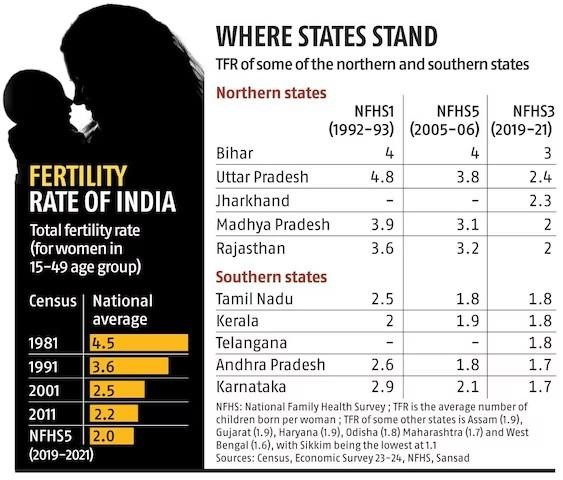Southern States’ Fertility Policies and Political Representation Debate
Syllabus:
GS-1:Population and Associated Issues , Human Resource
GS-2:Salient Features of Indian Society
Focus:
The debate over reversing fertility decline and its impact on political representation has intensified, especially in Southern States. The proposed policies to encourage larger families aim to prevent potential loss of parliamentary seats, raising concerns over the fairness of population-based political representation in India.
Introduction: The Delimitation Debate
- Concern over Loss of Parliamentary Seats:
Recently, Chief Ministers of Andhra Pradesh and Tamil Nadu, N. Chandrababu Naidu and M.K. Stalin, voiced concerns about the proposed delimitation exercise, fearing the loss of parliamentary seats. - Impact of Fertility Transition:
Southern states like Andhra Pradesh and Tamil Nadu have made significant strides in family planning, resulting in a lower population growth compared to northern states. This fertility transition could lead to a reduced share in parliamentary representation. - Proposed Legislative Responses:
Andhra Pradesh proposed legislation restricting candidates with more than two children from contesting local elections, with Naidu suggesting the reversal of a previously enacted law. Tamil Nadu’s Stalin humorously commented on increasing the number of children to counter the looming political impact.
Fertility Rate in India – Key Points:
- Decline in TFR:
- Total Fertility Rate (TFR) in India decreased to 2.0 (NFHS-5, 2019-21), below replacement level fertility (2.1).
- Regional Disparities:
- Southern States (e.g., Tamil Nadu, Andhra Pradesh) show sharper declines (TFR: 1.4, 1.5) compared to northern States (e.g., Uttar Pradesh, Bihar) with higher TFR (2.7, 3.0).
- Factors Behind Declining Fertility:
- Family Planning: Increased demand for family planning (76% women, NFHS-5).
- Educational Empowerment: More women in labor force reduces family size.
- Living Costs: Rising costs discourage larger families.
- Concerns with Decline:
- Ageing Societies: Increased pressure on pensions and healthcare.
- Political Representation: Potential loss of parliamentary seats for states with slow population growth post-2026.
- Labour Shortages: Potential workforce scarcity, as seen in Japan.
Challenges of Reversing Fertility Decline
- The Nature of Fertility Transition:
Fertility decline, once achieved, is difficult to reverse. Low fertility rates, a result of social, economic, and cultural shifts, cannot be altered easily through incentives or policy changes. Despite this, certain countries, like China, have attempted to reverse declining fertility rates without much success. - China’s One-Child Policy Example:
China’s one-child policy is an example of forced population control, with severe long-term consequences. The policy led to demographic imbalances, including a skewed marriage market, aging population, and significant social security challenges. The reversal of fertility trends in such cases has been problematic, demonstrating that interventionist policies can lead to unintended social and economic consequences. - Ineffectiveness of Incentives for Higher Fertility:
Countries such as Japan and South Korea have attempted pro-natal policies to encourage higher birth rates, but these efforts have largely been ineffective. Fertility rates remain low, and social structures struggle to accommodate the needs of growing populations.
The Issue of Political Representation and Population Counts
- Population Momentum and Regional Disparities:
While fertility rates may be declining in southern states, the demographic divide between regions persists. A population momentum ensures that the demographic differences between states will continue, complicating political representation. - Flaws in Delimitation Based on Population:
The delimitation process, which seeks to allocate seats based on population counts, risks reinforcing imbalances. For instance, states with lower population growth may lose representation, even though their success in population control has contributed to national development. - Incentivizing Development Through Population Control:
Regions that have successfully implemented population control measures should not be penalized through reduced political representation. Instead, political outcomes should take into account other factors, such as education levels and economic contributions, alongside population figures.
Impact on Women and Social Support
- Women’s Role in Fertility Reversal:
Encouraging women to have more children may not be as simple as it seems. The costs and challenges associated with raising children in contemporary society are significant, and women bear the brunt of these burdens. - Social Support Deficiencies:
If states wish to reverse fertility decline, they must first address the lack of social support for women. The state must ensure adequate infrastructure, healthcare, and financial support for families to raise children. Without such support, simply encouraging higher fertility will not succeed. - Women’s Empowerment and Fertility Control:
Women’s empowerment, education, and career opportunities play a critical role in fertility decisions. In many cases, a woman’s decision to have fewer children is influenced by these factors, and reversing this trend without providing proper support systems is unrealistic.
The Real Solution: Revising Political Representation
- Equitable Representation:
The core issue is not reversing fertility rates but rather ensuring equitable political representation for states with lower populations due to successful family planning initiatives. A population-based approach to delimitation needs to be reconsidered in favor of a more balanced system. - Characteristics-Based Political Representation:
Political representation should not solely be based on population counts. Characteristics such as economic development, education levels, and demographic contributions should be factored in to ensure fairness and uphold federal principles. - Emphasis on Migration:
In the short term, migration could serve as a solution to regional imbalances in population and political representation. Encouraging migration from regions with higher population growth to those with lower growth may help balance the demographic divide.
Challenges:
- Difficulty in Reversing Fertility Decline:
- Once fertility rates decline, reversing this trend proves to be nearly impossible due to natural societal shifts, making efforts to increase fertility unsustainable.
- Ineffective Pro-Natal Policies:
- Countries like China, Japan, and South Korea have implemented policies to boost birth rates, but these have shown limited success in reversing the declining fertility trends.
- Imbalance in Population Distribution:
- Delimitation based purely on population can lead to a disproportionate loss of political representation for states that have successfully controlled their population growth.
- Burden on Women:
- Encouraging higher fertility rates without providing adequate support systems, including healthcare, financial aid, and childcare facilities, places an undue burden on women.
- Federal Imbalances:
- Population-based political representation can exacerbate federal imbalances, ignoring factors like economic development and education, which are crucial for fair representation.
Way Forward:
- Revised Delimitation Criteria:
- Political representation should not solely rely on population size; it should factor in economic, educational, and developmental contributions to create a fairer system.
- Support for Women and Families:
- States should implement social support systems that help women balance career and family responsibilities, ensuring they have the resources needed to raise children.
- Encourage Regional Migration:
- Promoting migration from high fertility regions to lower fertility areas could help balance population distribution and reduce regional disparities.
- Holistic Policy Approach:
- Rather than focusing on fertility rates, the focus should be on improving education, healthcare, and economic development to promote sustainable population growth.
- Balanced Representation:
- Political representation should be based on a comprehensive assessment of demographic, social, and economic factors, ensuring equitable distribution of seats.
- Political representation should reflect broader development achievements, not just population size.
- Women’s empowerment and social support are essential to addressing fertility trends.
- Delimitation based purely on population numbers can create unfair imbalances, which need revisiting.
Conclusion: A Focus on Comprehensive Solutions
- Revising Delimitation:
The solution to regional population imbalances lies not in reversing fertility trends but in revising the delimitation exercise. A more holistic approach to political representation, considering factors beyond just population counts, is necessary. - Long-Term Vision:
The southern states’ efforts to reverse fertility decline through incentives may be short-sighted and ineffective in the long run. Instead, the focus should be on supporting women, enhancing social infrastructure, and ensuring a balanced approach to political representation based on multiple characteristics. - Balancing Fertility and Development:
Fertility rates should not be artificially manipulated to serve political goals. Sustainable population growth and demographic shifts should be embraced, with the state’s focus on developing robust social support systems and revising outdated political frameworks for a more equitable future.
Source: The Hindu
Mains Practice Question:
How can India address the challenges of political representation in light of regional demographic imbalances? Discuss the need for revised criteria in delimitation exercises and explore alternative solutions to ensure equitable representation for states that have successfully controlled their population growth.






